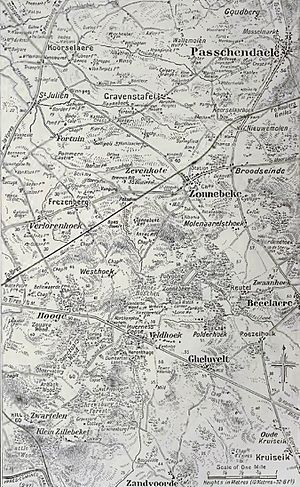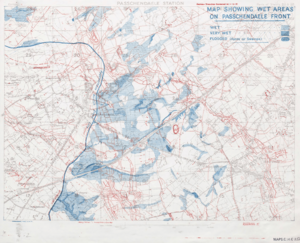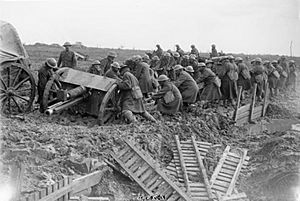Battle of Poelcappelle facts for kids
Quick facts for kids Battle of Poelcappelle |
|||||||
|---|---|---|---|---|---|---|---|
| Part of the Battle of Passchendaele in the First World War | |||||||
 Street corner in Poelcappelle |
|||||||
|
|||||||
| Belligerents | |||||||
|
|
|||||||
| Commanders and leaders | |||||||
| Herbert Plumer Hubert Gough François Anthoine |
Erich Ludendorff Crown Prince Rupprecht Sixt von Armin |
||||||
| Strength | |||||||
| 10+ divisions | 7 divisions, plus 6 divisions in reserve | ||||||
| Casualties and losses | |||||||
| 9 October: Second Army: I Anzac Corps: 1,253 II Anzac Corps: ~5,700 Fifth Army: ~4,500 |
1–10 October: 35,000 including 13,000 missing | ||||||
The Battle of Poelcappelle was a major fight during the First World War. It took place in Flanders, Belgium, on 9 October 1917. British and French forces fought against the German 4th Army. This battle was part of the larger Third Battle of Ypres, also known as the Battle of Passchendaele.
Before this battle, the British had some successful attacks. However, the Battle of Poelcappelle marked the end of these successes. Heavy rains began on 3 October, turning the battlefield into a muddy swamp. This made it very hard for the British to move their artillery and supplies. The German defenses held strong against the limited British artillery fire. The battle was tough for both sides, and many wounded soldiers were stuck in the mud.
Contents
Why the Battle Happened
Keeping the Pressure On
It was important for the British to keep attacking. They wanted to stop German soldiers from moving to other battlefronts. For example, the French army had faced some problems earlier in the year. Keeping the Germans busy in Flanders helped the French. Also, many German divisions had already fought in Flanders. Continuing the attacks meant these German soldiers could not go to the Russian or Italian fronts.
After a big British victory on 4 October, the British commander, Sir Douglas Haig, thought the German army was close to giving up. He believed this because many German soldiers were captured. He also got good information from the battlefield.
Planning the Attack
On 28 September, Haig met with his generals, Hubert Gough and Herbert Plumer. Haig wanted to make a deeper attack and be ready to push even further if it went well. He wanted to have extra soldiers, artillery, cavalry, and tanks ready.
However, Generals Gough and Plumer thought this plan was too soon. They believed the British needed to capture Passchendaele ridge first. They thought this would take two more attacks, each a few days apart. Then, it would take another four days to fix the roads. Haig agreed to prepare for a deeper advance, just in case the German defenses collapsed.
On 2 October, Haig announced that fighting at Ypres would continue as long as the weather allowed. Six new divisions were moved to the Fifth Army. The Canadian Corps also moved to the Second Army. If the attack on 10 October succeeded, reserve brigades would continue the advance in the afternoon.
Getting Ready for Battle
British Challenges
On 4 October, the British learned their attack had been very successful. Haig wanted to push forward even more. But General Plumer disagreed. He knew the Germans had many fresh divisions ready to fight. He also pointed out that the British artillery was stuck behind two miles of muddy ground. Moving the heavy guns forward would be impossible.
Rain started again on 4 October and continued for several days. On 7 October, it became a heavy downpour. This made the ground even worse. From 4 to 9 October, over 30 millimeters of rain fell. This was a lot for one week. The ground became "a porridge of mud."
Moving supplies and artillery was a huge problem. Plank roads, built to help transport, sank or floated away. Many field guns could not be moved forward as planned. This meant they were too far away to hit German targets. Gunners faced terrible conditions, with their dugouts flooding. Illness increased, and it was hard to replace soldiers. Some artillery units had very few working guns.
Transporting ammunition was also very difficult. Journeys that used to take one hour now took 6 to 16 hours. Ammunition arrived covered in mud. However, further north, where the ground was not as damaged by shelling, conditions were slightly better. Artillery could be moved closer to the front.
The British Plan
The attack was planned for 9 October, earlier than first thought. It aimed to capture Passchendaele ridge in two stages. The first stage was a morning attack to capture the "red line." If successful, reserve troops would then advance to the "blue line" in the afternoon. However, because of the bad weather, Haig cancelled the afternoon attack on 7 October.
On the southern side, the X Corps would attack to keep German reserves busy. To the north, the I Anzac Corps and II Anzac Corps would lead the main attack. The II Anzac Corps, with the 66th and 49th divisions, would advance towards Passchendaele village and the Bellevue pillboxes. The Fifth Army, with the XVIII Corps and XIV Corps, would attack towards Poelcappelle and Houthoulst Forest. The French First Army would also attack on the far left.
German Preparations
The Germans also struggled with the weather. However, their positions were slightly better, so their routes to the front line were in better shape. One German soldier described the ground as "unbelievably boggy." He said he got stuck up to his knees in the mud.
On 7 October, the German 4th Army changed its defense plans. They moved their reserve battalions further back. More artillery was used to protect their counter-attack divisions. These counter-attack divisions were placed closer to the front. This was risky, but it allowed them to respond quickly.
On 9 October, the German commander, Ludendorff, complained that these reserve divisions were not being used correctly. He said they were poorly organized and suffered too many casualties. He stressed that reserve units should only make quick counter-attacks to push back attackers. Larger, organized counter-attacks should be done by special reserve units, and only if the lost ground was very important.
The Battle of Poelcappelle
Second Army Attacks
| Date | Rain mm |
°F | |
|---|---|---|---|
| 3 | 1.2 | 64 | dull |
| 4 | 4.6 | 60 | dull |
| 5 | 3.1 | 52 | dull |
| 6 | 2.1 | 47 | dull |
| 7 | 10.4 | 53 | dull |
| 8 | 14.6 | 54 | dull |
| 9 | 0.0 | 53 | fine |
In the south, the British 5th Division attacked Polderhoek Château. They reached the ruins, but mud jammed many of their weapons. German machine guns forced them back. Further north, the 7th Division advanced well, capturing their objective quickly. They even reported that many Germans were running away.
In the I Anzac Corps area, the 1st Australian Division suffered heavy losses in Celtic Wood. The 2nd Australian Division tried to advance but was stopped by German machine guns. German reinforcements then moved behind the Australians, forcing them to pull back.
The main attack was by the II Anzac Corps. Their soldiers had to march for five hours in the dark, rain, and mud. Many units were late for the attack. When the artillery barrage began, it was hard to follow. Many shells got stuck in the mud, and some guns fired inaccurately.
The 66th Division on the right advanced quickly. They captured many German prisoners and reached their final objective. A patrol even found Passchendaele village empty. But then, German machine guns opened fire from the right. The brigade pulled back to the "red line." The 198th Brigade on the left struggled through deep mud. German machine guns from Bellevue pillboxes stopped them.
The 49th Division's attack also stalled in the mud. The artillery barrage was too thin and moved too fast. German machine guns fired through the British barrage. One attack got very close to Bellevue, but more barbed wire and hidden machine guns stopped them. After many attempts, the soldiers dug in halfway up the slope.
By the afternoon, the 49th Division had suffered 2,500 casualties. Small groups of soldiers were isolated further up the slopes.
Fifth Army Attacks
In the XVIII Corps area, British brigades took 14 and a half hours to reach the front line through mud and rain. When they attacked, German machine guns opened fire from close by. The British artillery barrage was ineffective, and the German pillboxes were mostly untouched. The British advance was stopped, and they had to pull back.
In the XIV Corps area, the 4th Division advanced just beyond Poelcappelle. The 29th Division had a longer advance planned. Their soldiers had moved up in torrential rain the night before. The attack began at 5:20 a.m. On the right, German machine guns caused many casualties. But the British reached their first objective. They captured 200 prisoners. German counter-attacks were defeated, and the final objective was reached.
The Guards Division had to cross the Broembeek stream. They carried forward many mats and footbridges to help. The rain stopped at midnight, and the morning was fine. Crossing the Broembeek was easier than expected, as many German soldiers surrendered. The Guards reached their final objective, taking a German strongpoint later. German snipers in Houthoulst Forest caused problems. No major counter-attack happened until the evening.
French Army Attacks
The French First Army attacked alongside the British. Their artillery bombarded German defenses for three days. At 5:30 a.m., their artillery barrage began to move slowly over the mud. The French artillery was very effective. Despite the extremely slow advance due to the mud, the French reached their objectives by 10:00 a.m. with few casualties.
The French 2nd Division crossed the flooded Broembeek. They captured the villages of St Jean, Veldhoek, and Mangelaere. They also pushed back Germans from fortified farms and pillboxes. The French advanced about 1.25 miles in four hours, with fewer than 500 casualties. They took 300 prisoners. French planes flew low, firing at German soldiers and scouting. The attack on the left side of the battle was a complete success.
Air Operations
The good weather ended on 4 October. Heavy rain and low clouds made it hard for planes to fly. From 5 to 9 October, British planes could not observe German artillery. This meant the British could not effectively target German guns. Wire cutting by artillery was also not good enough.
On 9 October, very little flying was possible. However, some British aircrews managed to fly low. They reported on the attack's progress and called in artillery strikes on German positions. They engaged 21 German artillery batteries for destruction and 33 for neutralization. British planes also flew reconnaissance missions and shot down four German fighters.
German Response
The German 233rd Division did not need help. But to counter-attack the II Anzac Corps, the 16th and 195th Divisions were supported by parts of the 20th and 45th Reserve Divisions. The 240th Division was sent to support the 6th Bavarian Division near Poelcappelle. They moved under heavy fire and managed to regain some lost ground. The battle continued with small gains by each side. After many German counter-attacks during the night, the British were mostly back to where they started. German historians called the battle a costly defensive success.
After the Battle
Casualties
The 7th Division had 3,877 casualties from 1 to 10 October. In the Ravebeek valley, some wounded soldiers drowned in shell-holes filled with rain. An Australian officer found about fifty wounded British soldiers who had been there for four days. The next day, some were still there, seven days wounded and not looked after.
The New Zealand Division found wounded soldiers from the 49th Division who were hungry and not cared for. Those who could not be moved were treated in muddy shell holes. Many died from exposure to the wet and cold weather. Even before the attack, aid stations were full of wounded soldiers.
Historian Robert Perry noted that Second Army casualties were 1,253 in the 2nd Australian Division and about 5,700 in the II Anzac Corps. The 66th Division had 3,119 losses, and the 49th Division had 2,585 casualties. German historians recorded 35,000 casualties, including 13,000 missing, for the period of 1 to 10 October.
What Happened Next
The 66th Division fought off a German counter-attack on 10 October. Many British divisions were replaced before 12 October. The First Battle of Passchendaele took place on 12 October. The British gained some ground in the north, but most early gains around Passchendaele were lost to German counter-attacks. The battle was a German defensive success, but both sides suffered many losses. British attacks were put on hold until the weather got better. Two German divisions meant for Italy were sent to Flanders instead, because of the "extraordinarily high" losses.
Victoria Cross Heroes
The Victoria Cross is the highest military award for bravery. These soldiers earned it during the battle:
- Corporal William Clamp, 6th Green Howards
- Private Frederick Dancox, 4th Worcesters
- Sergeant Joseph Lister, 1st Lancashire Fusiliers
- Sergeant John Molyneux, 2nd Royal Fusiliers
- Lance-Sergeant John Rhodes, 3rd Grenadier Guards
|








